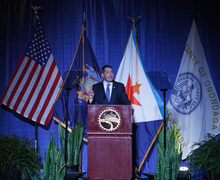Opinion: Voting in local, state elections matters
Emma Lee | Contributing Illustrator
"Quality of life for residents in any state heavily depends on the representatives they elect." Our columnist says that the most impactful decisions often happen closer to home.
Get the latest Syracuse news delivered right to your inbox.
Subscribe to our newsletter here.
Election season is officially underway and all eyes are on the presidential election.
Eye-catching “vote” pins can be seen everywhere worn on the shirts of those hopeful of a large voter turnout. While this is a nice effort, there is a more important fight to be won.
State and local elections have become increasingly important with issues such as abortion rights on the ballot. These elections are determinants in the quality of life of residents of the state. It is commonplace to hear people referring to the politics within red and blue states as if they were completely different countries. This division highlights the necessity for voting in local and state elections. However, this urgency is not met by voters.
Voter participation in local and state elections consistently lags behind that of federal elections, with turnout often dipping below 20% in some areas. The 2022 midterm elections saw a voter turnout of 52.2%, a slight drop from the 53.4% recorded in 2018. Participation in local elections is even more concerning, with some municipal contests seeing turnout rates as low as 6.9%. The stark contrast underscores a troubling disconnect between the importance of these elections and the level of public engagement they receive.

Ilana Zahavy | Design Editor
One significant factor contributing to low voter turnout in local elections is the timing. When held in years when there isn’t a presidential election, voter participation tends to be much lower. Unlike presidential elections, which receive extensive media coverage that indirectly promotes local elections, these smaller contests often receive little to no attention from major news outlets. This lack of coverage leaves many voters uninformed about the candidates and issues on the ballot, further diminishing turnout. Without the visibility that presidential election years provide, local elections often fall off the public radar, emphasizing the need for better media engagement and voter awareness efforts.
Quality of life for residents in any state heavily depends on the representatives they elect. A key topic of discussion is the recent Supreme Court decision that, after overturning Roe v. Wade, has returned the issue of abortion to the states. Several states, including California, Ohio and Michigan have held ballot referendums on abortion rights. This is not the first time significant political issues have appeared on ballots; the legalization of marijuana is another example. With critical political issues on the ballots in upcoming elections, it is essential to participate in state-level elections to elect those who we feel best represent us in order to influence the direction of these vital decisions.
The positions that our elected officials hold in the House of Representatives and the Senate significantly influence the power of the president. In the Senate, filibusters — a procedural tactic used to delay or block legislative action — can play a crucial role in shaping the outcome of proposed policies. This can effectively stall or prevent the passage of legislation, even if it has majority support, by obstructing the legislative process. Filibusters have historically been used to delay or block significant policies, including civil rights legislation and more recent efforts related to healthcare and voting rights policy. Understanding the impact of filibusters is essential in assessing the balance of power within the federal government and the ability of the president to enact their agenda.
In the complex balance of American power, Congress often exerts influence that can eclipse even the president’s authority. This was evident in 2021 when Senate Republicans used the filibuster to block the For The People Act, a key voting rights bill supported by President Joe Biden. Despite its broad public backing, the legislation never reached a full Senate vote, demonstrating how a determined minority in Congress can effectively halt the president’s agenda. Even in critical moments, the power to shape the nation’s future often rests not with the president, but with the Senate and House of Representatives.
As election season heats up and attention zeroes in on the presidential race, it’s important to remember that the most impactful decisions often happen closer to home. State and local elections play a crucial role in shaping the policies that directly affect our daily lives, from healthcare and education to complex issues like reproductive rights. Yet, voter turnout in some of these elections remains dismally low. The decisions made at the state and local levels will define the future of our communities. Now is the time to engage fully in these elections and to recognize that the votes we cast locally are just as vital, if not more so, than those at the national level.
Max Lancer is a junior with a triple major in chemistry, biochemistry and mathematics. His column appears weekly. He can be reached at mlancer@syr.edu
Published on September 2, 2024 at 11:29 pm






